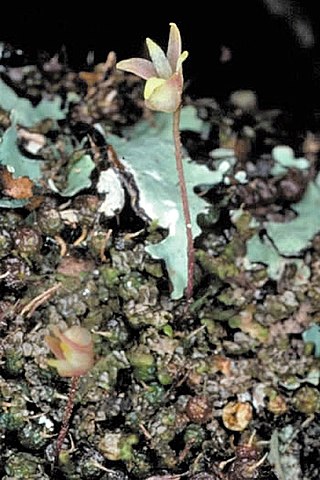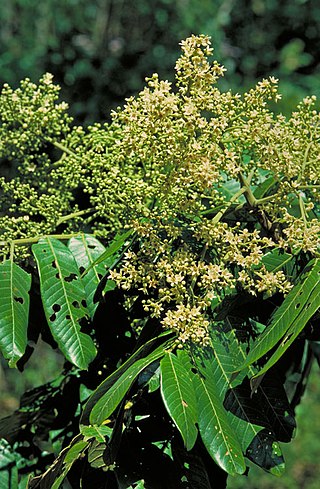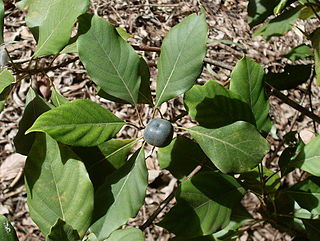
Bulbophyllum globuliforme, commonly known as the green bead orchid, miniature moss-orchid or hoop pine orchid, is a species of epiphytic orchid with tiny spherical pseudobulbs, scale-like leaves and small cream-coloured flowers with a yellow labellum. It grows on the scaly bark of hoop pine, mostly on the McPherson Range on the New South Wales/Queensland border in eastern Australia. Because of its small size it is often dismissed as moss.

Cordyline obtecta is a widely branching monocot tree native to Norfolk Island, and to northern New Zealand. The species name obtecta derives from the Latin obtegere, alluding to the way the inflorescence barely protruded beyond the leaves in the plant first described.

Flindersia schottiana, commonly known as bumpy ash, cudgerie or silver ash, is a species of rainforest tree in the family Rutaceae and is native to New Guinea and eastern Australia. It has pinnate leaves with mostly ten to sixteen leaflets, panicles of white flowers and woody fruit studded with rough points.

Elaeocarpus sedentarius, commonly known as Minyon quandong, is a species of flowering plant in the family Elaeocarpaceae and is endemic to a restricted area of New South Wales. It is a medium-sized to large tree with elliptic to egg-shaped leaves, racemes of whitish flowers and more or less spherical blue fruit.

Flindersia australis, commonly known as crow's ash, flindosy or Australian teak, is a species of tree that is endemic to north-eastern Australia. It has pinnate leaves with between five and thirteen egg-shaped to elliptical leaflets, white to cream-coloured flowers arranged in panicles on the ends of branchlets and followed by woody capsules studded with short, rough points and containing winged seeds.

Syzygium hemilamprum, commonly known as the broad-leaved lilly pilly, blush satinash, cassowary gum, Eungella gum, and treated as Acmena hemilampra in New South Wales and Queensland, is a species of flowering plant in the family Myrtaceae and is native to New South Wales, Queensland and the Northern Territory. It is a rainforest tree with broadly lance-shaped to elliptic leaves, panicles of white flowers and more or less spherical white fruit.

Acronychia wilcoxiana, commonly known as silver aspen, doughwood, snowwood or mushyberry, is a species of small rainforest tree that is endemic to eastern Australia. It has simple, elliptical to egg-shaped leaves with the narrower end towards the base, relatively large groups of whitish flowers in leaf axils and broadly oval to more or less spherical, white fruit.

Bosistoa transversa, commonly known as yellow satinheart, or three-leaved bosistoa, is a species of small to medium-sized rainforest tree that is endemic to eastern Australia. It has mostly pinnate leaves, usually with three leaflets, and panicles of small white flowers.

Linum marginale, commonly known as native flax or wild flax, is a species of flowering plant in the family Linaceae and is endemic to Australia. It is a perennial herb with few branches, linear leaves, and blue flowers with five usually blue petals with darker veins.

Micromelum minutum, commonly known as limeberry, dilminyin. kimiar margibur, tulibas tilos (Philippines), sesi (Indonesia) and samui (Thailand), is a species of small tree or shrub in the citrus plant family Rutaceae. It occurs from India and Indochina to Australia. It has pinnate leaves with egg-shaped to lance-shaped leaflets, hairy, pale green or creamish, scented flowers arranged in large groups and yellow to orange or red, oval to spherical berries in dense clusters.

Chenopodium spinescens is a species of plant in the family Amaranthaceae and is endemic to all mainland states and territories of Australia where it is known as Rhagodia spinescens.

Dianella longifolia, commonly known as blueberry lily, pale flax lily or smooth flax lily, or blue flax-lily, is a species of flowering plant in the family Asphodelaceae and is endemic to non-arid areas of Australia. It is a tufted, rhizomatous, perennial herb with grass-like leaves, pale blue, white or greenish flowers that have pale yellow anthers, and shiny, pale blue berries.

Bosistoa medicinalis, commonly known as the northern towra or Eumundi bosistoa, is a species of small to medium-sized rainforest tree that is endemic to Queensland. It has simple and pinnate leaves with two or three leaflets and panicles of small white flowers.
Acronychia aberrans, commonly known as acid berry, lemon aspen, plasticine tree or plasticene aspen, is a species of medium-sized rainforest tree that is endemic to north-eastern Queensland. It has simple leaves on stems that are more or less square in cross-section, flowers in small groups in leaf axils and fleshy, more or less spherical fruit.

Acronychia acuminata, commonly known as Thornton aspen, is a species of shrub or small rainforest tree that is endemic to north-eastern Queensland. It has simple leaves on stems that are more or cylindrical, flowers in small groups in leaf axils and fleshy, oval to spherical fruit.

Coatesia is a genus of plant containing the single species Coatesia paniculata, commonly known as axe-breaker or capivi, and is endemic to eastern Australia. It is a small, evergreen tree with simple, elliptical to egg-shaped leaves, panicles of white flowers on the ends of branchlets or in leaf axils and fused follicles with one black seed in each follicle.

Flindersia acuminata, commonly known as silver silkwood, icewood, Putt's pine, Paddy King's beech or silver maple, is a species of tree that has pinnate leaves with between six and ten egg-shaped to elliptic leaflets, creamy yellow flowers arranged in panicles, and fruit studded with short, rough points.
Goodenia purpurascens is a species of flowering plant in the family Goodeniaceae and is native to northern Australia and New Guinea. It is usually a perennial herb with linear to lance-shaped leaves at the base of the plant, and thyrses or panicles of purple flowers.

Pomaderris cocoparrana, commonly known as Cocoparra pomaderris, is a species of flowering plant in the family Rhamnaceae and is endemic to a restricted area of New South Wales. It is a shrub with hairy stems, egg-shaped to more or less round leaves, and clusters of yellow flowers.

Pomaderris pallida, commonly known as pale pomaderris, is a species of flowering plant in the family Rhamnaceae and is endemic to the south-east of continental Australia. It is a compact, rounded shrub with hairy stems, narrowly elliptic to narrowly oblong leaves and panicles of cream-coloured flowers.




















